JAK2/IDH-mutant-driven myeloproliferative neoplasm is sensitive to combined targeted inhibition
- PMID: 29355841
- PMCID: PMC5785272
- DOI: 10.1172/JCI94516
JAK2/IDH-mutant-driven myeloproliferative neoplasm is sensitive to combined targeted inhibition
Erratum in
-
JAK2/IDH-mutant-driven myeloproliferative neoplasm is sensitive to combined targeted inhibition.J Clin Invest. 2018 Oct 1;128(10):4743. doi: 10.1172/JCI124920. Epub 2018 Sep 17. J Clin Invest. 2018. PMID: 30222137 Free PMC article. No abstract available.
Abstract
Patients with myeloproliferative neoplasms (MPNs) frequently progress to bone marrow failure or acute myeloid leukemia (AML), and mutations in epigenetic regulators such as the metabolic enzyme isocitrate dehydrogenase (IDH) are associated with poor outcomes. Here, we showed that combined expression of Jak2V617F and mutant IDH1R132H or Idh2R140Q induces MPN progression, alters stem/progenitor cell function, and impairs differentiation in mice. Jak2V617F Idh2R140Q-mutant MPNs were sensitive to small-molecule inhibition of IDH. Combined inhibition of JAK2 and IDH2 normalized the stem and progenitor cell compartments in the murine model and reduced disease burden to a greater extent than was seen with JAK inhibition alone. In addition, combined JAK2 and IDH2 inhibitor treatment also reversed aberrant gene expression in MPN stem cells and reversed the metabolite perturbations induced by concurrent JAK2 and IDH2 mutations. Combined JAK2 and IDH2 inhibitor therapy also showed cooperative efficacy in cells from MPN patients with both JAK2mut and IDH2mut mutations. Taken together, these data suggest that combined JAK and IDH inhibition may offer a therapeutic advantage in this high-risk MPN subtype.
Keywords: Drug therapy; Hematology; Leukemias; Oncology.
Conflict of interest statement
Figures
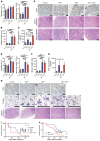
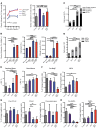
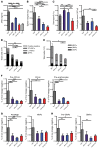
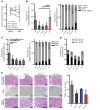
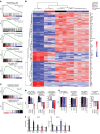



Similar articles
-
Metabolic Vulnerabilities and Epigenetic Dysregulation in Myeloproliferative Neoplasms.Front Immunol. 2020 Nov 30;11:604142. doi: 10.3389/fimmu.2020.604142. eCollection 2020. Front Immunol. 2020. PMID: 33329600 Free PMC article. Review.
-
Overview of Transgenic Mouse Models of Myeloproliferative Neoplasms (MPNs).Curr Protoc Pharmacol. 2017 Jun 22;77:14.40.1-14.40.19. doi: 10.1002/cpph.23. Curr Protoc Pharmacol. 2017. PMID: 28640953 Free PMC article. Review.
-
IDH1 and IDH2 mutation analysis in chronic- and blast-phase myeloproliferative neoplasms.Leukemia. 2010 Jun;24(6):1146-51. doi: 10.1038/leu.2010.77. Epub 2010 Apr 22. Leukemia. 2010. PMID: 20410924
-
Targeting compensatory MEK/ERK activation increases JAK inhibitor efficacy in myeloproliferative neoplasms.J Clin Invest. 2019 Mar 4;129(4):1596-1611. doi: 10.1172/JCI98785. eCollection 2019 Mar 4. J Clin Invest. 2019. PMID: 30730307 Free PMC article.
-
JAK-mutant myeloproliferative neoplasms.Curr Top Microbiol Immunol. 2012;355:119-33. doi: 10.1007/82_2011_170. Curr Top Microbiol Immunol. 2012. PMID: 21823028 Review.
Cited by
-
Specific patterns of H3K79 methylation influence genetic interaction of oncogenes in AML.Blood Adv. 2020 Jul 14;4(13):3109-3122. doi: 10.1182/bloodadvances.2020001922. Blood Adv. 2020. PMID: 32634241 Free PMC article.
-
The role of driver mutations in myeloproliferative neoplasms: insights from mouse models.Int J Hematol. 2020 Feb;111(2):206-216. doi: 10.1007/s12185-019-02803-x. Epub 2019 Dec 21. Int J Hematol. 2020. PMID: 31865539 Review.
-
Molecular Pathogenesis of Myeloproliferative Neoplasms: From Molecular Landscape to Therapeutic Implications.Int J Mol Sci. 2022 Apr 20;23(9):4573. doi: 10.3390/ijms23094573. Int J Mol Sci. 2022. PMID: 35562964 Free PMC article. Review.
-
Leukemia secondary to myeloproliferative neoplasms.Blood. 2020 Jul 2;136(1):61-70. doi: 10.1182/blood.2019000943. Blood. 2020. PMID: 32430500 Free PMC article. Review.
-
Leukemic Transformation of Myeloproliferative Neoplasms: Therapeutic and Genomic Considerations.Curr Hematol Malig Rep. 2018 Dec;13(6):588-595. doi: 10.1007/s11899-018-0491-5. Curr Hematol Malig Rep. 2018. PMID: 30353413 Review.
References
-
- Mesa RA, Li CY, Ketterling RP, Schroeder GS, Knudson RA, Tefferi A. Leukemic transformation in myelofibrosis with myeloid metaplasia: a single-institution experience with 91 cases. Blood. 2005;105(3):973–977. - PubMed
Publication types
MeSH terms
Substances
Grants and funding
LinkOut - more resources
Full Text Sources
Other Literature Sources
Molecular Biology Databases
Miscellaneous

